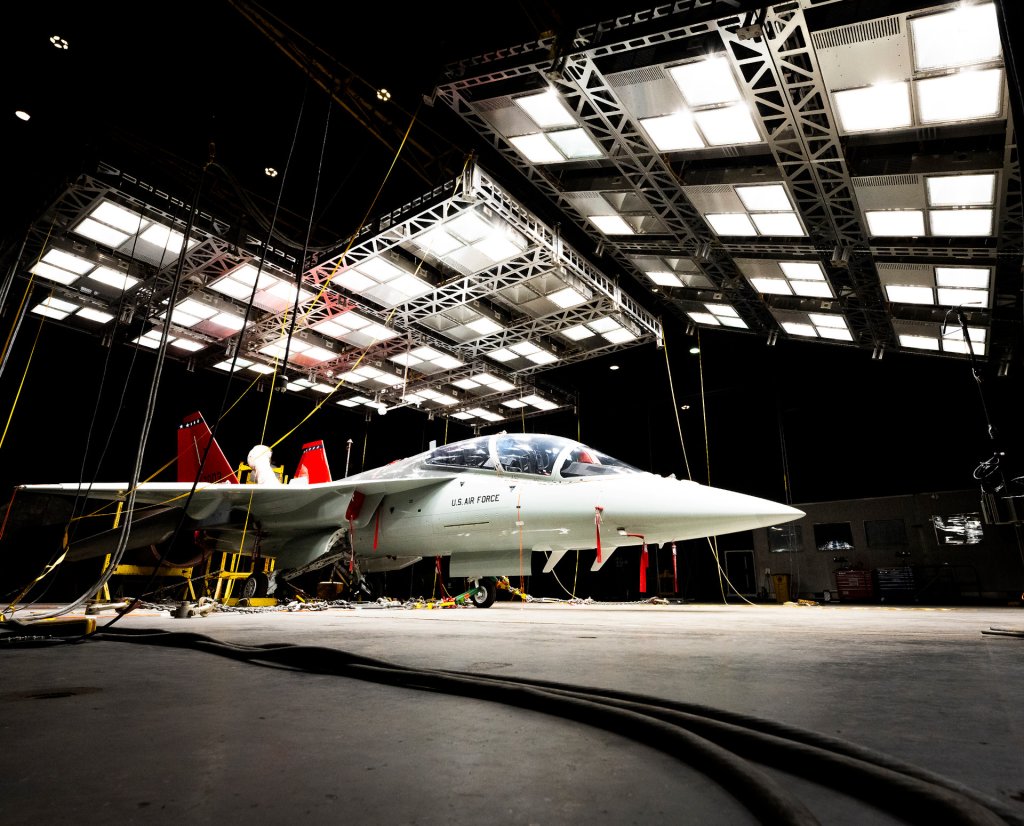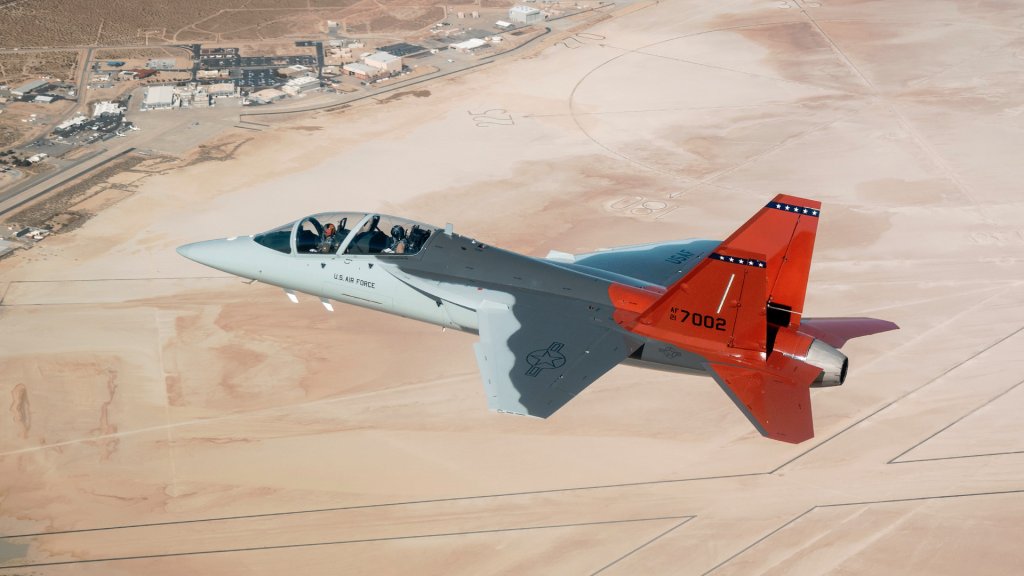New information about serious and potentially dangerous deficiencies with the emergency ejection system on the U.S. Air Force’s new T-7A Red Hawk jet trainer has been released. Environmental testing of the Red Hawk last year also exposed new problems that need to be addressed. The Air Force has been working with manufacturer Boeing to fix or otherwise mitigate a host of issues with the T-7A, which have already led to significant delays and prompted a recent shakeup of the overall plans for the program.
The Pentagon’s Office of the Director of Test and Evaluation (DOT&E) provided new updates on T-7A program in its most recent annual report, which it released last week. The report covers work done on various programs during Fiscal Year 2024, which ended on Sept. 30 of last year. TWZ has reached out to the Air Force and Boeing for any information on additional developments since then related to the Red Hawk’s ejection system, the problems uncovered in the environmental testing, and other issues. You can read more about what has previously been disclosed about T-7A testing in this recent TWZ feature.
The T-7A flew for the first time in 2023 and, as of December 2024, the Air Force had taken delivery of five pre-production test jets.
Regardless, what DOT&E’s newest report has disclosed now is concerning.
“As reported in the FY22 and FY23 Annual Reports, the T-7A emergency escape system does not meet minimum safety requirements for the Air Force’s airworthiness certification and is currently operating with high-risk acceptance for air worthiness,” according to DOT&E. “A February 2024 sled test showed improvement at medium-speed ejections for the ejection seat sequencing.”
However, “the program executed a high-speed test in June 2024 where the seat sequenced correctly, but a seat hose interfered with the seat sequencer switch, which could lead to an incorrect ejection mode,” the new report adds. “In the same test, the redesigned canopy fracturing system pattern did not function properly. The program must successfully complete seven more sled tests before the escape system can be certified for airworthiness and IOT&E [initial operational test and evaluation].”
The two-seat T-7A features ACES 5 ejection seats from Collins Aerospace, a subsidiary of Raytheon (now formally called RTX). Previous testing had uncovered problems with the complete emergency egress system that presented serious safety risks, especially for smaller and lighter female pilots, and during ejections at speeds under 250 knots. As DOT&E notes in its latest report, work has already been ongoing to address these deficiencies, which have been a key driver in delays to date.

“In February 2024, the program completed initial cold and hot weather testing at the McKinley Climatic Laboratory in Eglin, Florida. This initial round of testing revealed several problems that require a second test event at the McKinley Laboratory in 3QFY25 [third quarter Fiscal Year 2025, which begins in April],” DOT&E has also now disclosed. The report does not provide any specific details about the problems encountered in the environmental testing.
The Air Force did publicly announce the environmental testing at McKinley last year and said one of the T-7As had been subjected to temperatures as low as negative 25 degrees and as high as 110 degrees, both in Fahrenheit, as well as extreme humidity. The service made no mention of any problems at that time.


Other additional issues have been dogging the T-7A, but efforts continue to address or mitigate them.
“The [Red Hawk] program office also continued to make progress on the T-7A OBOGS [On-Board Oxygen Generation System]. The draft T-7A OBOGS test plan calls for 46 data points collected over 10 ground and 100 hours of flight test events, including high and sustained-g maneuvering,” DOT&E’s new report says. “The integrated test team will continue to collect OBOGS test data during future IOT&E, as system components age and approach regularly scheduled maintenance and replacement. DOT&E will evaluate OBOGS performance in accordance with the current military standards document (MIL-STD-3050A), which incorporates lessons learned from several fighter aircraft mishaps.”
As alluded to here, several U.S. military aircraft types have suffered from OBOGS-linked issues in recent years, some which have contributed to fatal mishaps, as TWZ has covered extensively in the past.
“AGCAS [Automatic Ground Collision Avoidance System] is another known suitability limitation [for the T-7A]. Fighter aircraft employ AGCAS to prevent loss of life during sustained high-g maneuvers, which can cause the pilot to lose consciousness,” according to DOT&E. “While the formal requirements for APT [the Advanced Pilot Training program] did not include AGCAS, the program office is developing a strategy to start AGCAS integration in FY26.”
Furthermore, “the majority of test points in the government DT [developmental test] test plan remain untested. These events include structural loads, subsystems, tanker formation, crew systems, On-Board Oxygen Generation System (OBOGS), mission systems, and high angle-of-attack testing, which have the potential to drive further software and flight control changes,” DOT&E highlights in its latest report. That being said, “the program appears to have a clear pathway to resolving known effectiveness issues, such as limited sortie duration and flight characteristics at high angles-of-attack.”

In 2021, Boeing said it resolved an issue involving wing-rock at high angles of attack, in part through the use of digital engineering processes. DOT&E’s report indicates that additional testing was still needed to validate that fix as of the end of Fiscal Year 2024.
It’s also worth noting here that the T-7A has been a poster child for the benefits of digital engineering and design tools, which Boeing has notably touted as making it easier to address issues uncovered during developmental testing. However, a significant consensus has emerged that these technologies have not shown themselves to be as revolutionary as hoped, as you can read more about here.

Whether or not the issues highlighted in the DOT&E latest report had been further addressed or mitigated in any way in the past four months, the T-7A program is already substantially delayed. The Air Force had hoped to reach initial operational capability with the Red Hawk in 2024, but that has now slipped to 2028. The service does not now even expect to order its first production T-7As until 2026.
In January, the Air Force announced major changes to the overall T-7A program plan, including its intention to purchase four more pre-production examples to support ongoing testing. Boeing has also been using two demonstrator aircraft to support work on the Red Hawk. The demonstrators were originally built as part of the company’s winning submission for the T-X jet trainer competition.

“Procuring these PRTVs [Production Representative Test Vehicles] in FY25 also allows the Air Force and Boeing to improve manufacturing readiness prior to entering the production phase for the entire run of over 350 T-7As,” Andrew Hunter, then-assistant secretary of the Air Force for Acquisition, Technology, and Logistics, said in a statement on Jan. 15. “Decreasing overlap between development, testing, and production lowers the likelihood of potential costly retrofits of a significant number of aircraft.”
All of this presents serious concerns for the Air Force’s already strained pilot training pipelines. The T-7As are in line to replace the service’s T-38 Talon jet trainers, the core design of which dates back to the 1960s and that are only becoming harder and harder to sustain.

Problems with the T-7A program, for which Boeing has a fixed-price contract, have led to financial trouble for the company, as well. Last month, Boeing announced that its Defense, Space & Security division had suffered another $500 million loss on T-7A tied, at least in part, to higher-than-expected costs associated with the planned start of production in 2026. The company has previously reported more than a billion dollars in losses on the program since winning the Air Force’s T-X jet trainer competition in 2018.
“Air Education and Training Command is actively working with our acquisitions partners to develop cutting edge training capabilities at the speed of need,” Air Force Lt. Gen. Brian S. Robinson, head of the Air Force’s top training command, said in January around the announcement of the Red Hawk program restructuring. “The T-7A will propel the Air Force’s pilot training pipeline into the future of aviation, enabling the Air Force to continue producing world-class pilots who meet the challenges of the future.”
No matter what the current state of the T-7A’s emergency ejection system is or what other work has been done since the end of Fiscal Year 2024, more work is clearly still needed before pilot trainees can start using the Red Hawks to get their wings.
Contact the author: joe@twz.com
